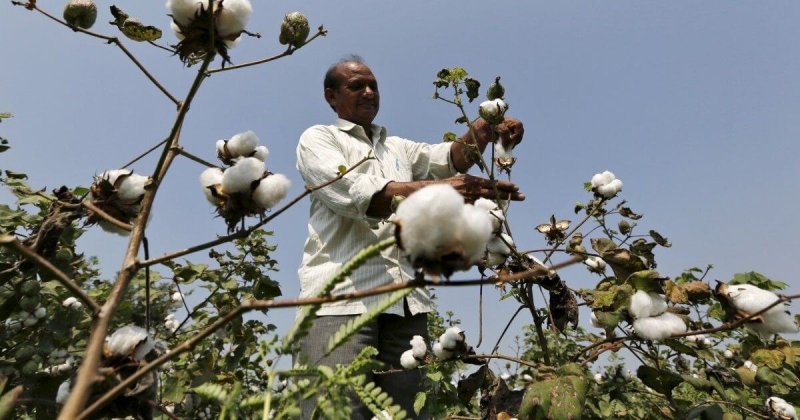Farmers around the world have cultivated genetically engineered (GE) crops for nearly thirty years. In that time, researchers have gathered a substantial amount of evidence confirming the safety and utility of GE traits. Many developing countries, after years of intense political debate, are examining this research and beginning to approve the release of crops with GE traits to achieve food security and make farming a viable enterprise for small landholders.
Critics of biotechnology, however, continue to challenge the cultivation of GE crops with outright fearmongering or, less frequently, sophisticated obfuscation of the benefits provided by GE technologies. Interestingly, some well-respected science journals on occasion feature opinion articles and research suggesting that the benefits of GE technology have been minimal. One such article, ‘Long-term impacts of Bt cotton in India,’ recently appeared in Nature Plants. In the following response, which Nature declined to publish, plant geneticist Deepak Pental challenges the authors’ analysis and finds that their conclusions are not supported by the facts.
— Editor
A ‘Perspective’ article titled ‘Long-term impacts of Bt cotton in India’ was recently published in Nature Plants1. At the center of the analysis is the controversial issue of the use of GE technologies for crop improvement. In this case, the authors focus on an insecticidal protein-encoding gene isolated from a soil bacterium, Bacillus thuringiensis (Bt), that was introduced into cotton for protection against lepidopteran pests – particularly, the American bollworm (ABW). Cotton with the Bt trait was officially released in India in 2002.
The article’s authors claim to have carried out ‘a new analysis of unprecedented scope, time depth and detail’ on cotton cultivation in India to find the real reasons behind the doubling of yields between 2000 and 2006, followed by yield stagnation. While the avowed goal of the analysis is to set the record right on the contribution of the Bt trait to cotton cultivation in India, the real purpose of the report is to cast doubts on the utility of GE technologies.
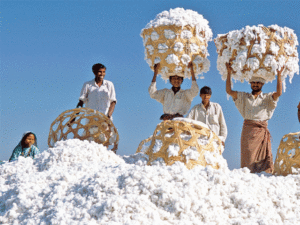
It is widely known that illegal Bt cotton seeds were available and sown extensively in the state of Gujarat during the 2001 growing season. This forced the government of India to make a decision, and Bt seeds were officially released in 2002 By 2007 cotton hybrids with the Bt trait covered around 60% of the area under cotton cultivation, and by 2010 about 85%. Many studies have attributed the yield and the overall production increase to the Bt trait. However, the authors’ of the present analysis contend that the doubling of India’s cotton yield since 2000 was due to a doubling of fertilizer application from 93 kg/ha in 2000 to more than 200 kg/ha in 2010. As for the contribution of the Bt trait, the authors claim “…. that the technology benefits have been modest and largely ephemeral.”
Has the Bt trait benefit been ephemeral?
“Ephemeral” is synonymous with “momentary” or “fleeting.” These are hardly the right words to describe the impact of a technology that has since 2002 provided protection against ABW, the chief destroyer of the cotton crop in India before the release of Bt cotton. Unlike in the case of herbicide-resistant GE crops, population geneticists had predicted that resistance to insect pests would not last. To prolong the life of the Bt trait, it was suggested that a refuge of non-Bt plants be grown, the dosage of the insecticidal protein should be high, and more resistance-conferring genes should be stacked in the plant2.
Remarkably, resistance conferred by the Bt gene(s) has held even though farmers in India have not always kept proper refuges of non-Bt plants. In the released Bt event, the amount of Bt protein decreases as the crop matures; expression in the bolls has been inadequate from the very beginning to fully control the Pink bollworm. However, the Bt trait continues to provide effective resistance against ABW. In the absence of the Bt technology, the cost and the use of insecticides would be even higher than what is projected in Fig. 8 of the Perspective article.
Menace of sap-sucking pests
In 2003 my colleagues and I published the results of a survey conducted among plant breeders in India regarding their objectives for some of the major crops3. For cotton, resistance to ABW was at the top of the list; however, susceptibility to whitefly and jassids were identified as the number two and three problems, respectively. Whitefly is also the insect vector that spreads cotton leaf curl-causing Gemini viruses; in the northern belt, leaf curl disease was seen as a major yield-limiting factor.
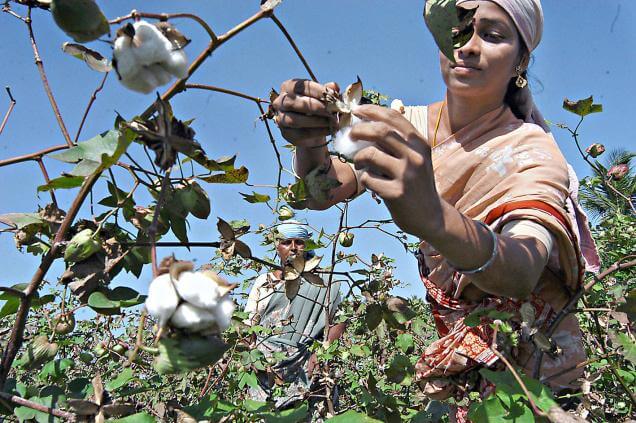
Since the survey, no biological solution has been implemented for tackling either of the two sap-sucking insects or the leaf curl disease. The authors claim that ‘sap-sucking insects thrive on fertilizer-intensive hybrids’ and further contend that ‘The hirsutum Bt hybrids are highly vulnerable to insects, unlike the public-sector varieties that were in wide use in the 1990s.” According to the authors, in the 1996 crop season, 32.9 percent area was already under hybrids. Why were the farmers switching to hybrids? Is it because the yields were higher? The authors also do not provide any evidence that public-bred varieties of G. hirsutum were more resistant than public- or private-bred hybrids.
Increasing yield: Productivity enhancement vs. productivity maintenance
While yield enhancement can be subjected to the classical experimental design of multisite replicated trials, it is difficult to estimate the contribution of productivity maintenance technologies. A typical example of productivity enhancement was the introduction of dwarf wheat and rice varieties in Asia. The dwarf Mexican wheat varieties could be easily compared with the tall Indian wheat varieties in multisite replicated trials. Productivity enhancement was obvious. Both economic and strategic needs led to a fast adoption.

However, the contribution of breeding for disease resistance has remained obscure. Imagine the state of global food security and the state of the environment if all the rust diseases of wheat had to be controlled by chemicals. Productivity maintenance technologies can be best dealt with using multifactor analyses and evidence for use (EFU)4. Two such peer-reviewed studies need a mention here5,6. The earlier study5 of the field trials of Bt and non-Bt isogenic lines recorded 80% yield increase with Bt hybrids and much-reduced expenditure on insecticides. Most of the reduction involved highly hazardous Class 1 and 2 insecticides. However, this study involved ‘ideal yields’ and did not represent ‘typical yields’. The Perspective article, while agreeing that the Bt trait reduced pesticide usage, points out that some very effective Class 3 insecticides were already available as an alternative to Bt-based control of the bollworm in 2002, showing their bias for chemical control to keep the GE technologies out.
A more extensive study,6 conducted between 2002 and 2008, on farmers’ fields reported a 24% increase in cotton yield through more effective pest control and a 50% increase in profit for small landholders. The Perspective takes recourse to “selection bias,” “cultivation bias,” and “time term bias” to cast doubt on the validity of such studies. Hicks4 rightly concludes that even if all the parties interested in GE crops agreed on the use of the EFU approach, there could be disagreement over what counts as evidence. The real divide here is ideological—on what kind of agricultural production systems and food regimes are desirable.
However, the authors, even though one of them is a social anthropologist, have no faith in EFU approaches. They want to see a GE-free world, and nudging policymakers in India in that direction will be an achievement of sorts. Such motivated analyses need critical scrutiny.
Cotton in India, the last fifty years
The history of cotton cultivation in India in the last half-century has been divided into four phases 7 —the pre-hybrid phase of 1960 to 1970, characterized by low yields with more than 90 % area under short-staple G. arboreum and G. herbaceum; the early hybrid phase from 1971 to 1991, in which public-bred G. hirsutum hybrids were slowly adopted in around 50% of the cotton-growing area with significant yield increase; the late hybrid phase from 1992 to 2001, characterized by yield fatigue and intensification of pest attacks; followed by the Bt hybrid phase from 2002 in which G. hirsutum hybrids with Bt trait covered almost 95 % of the cotton-growing area.
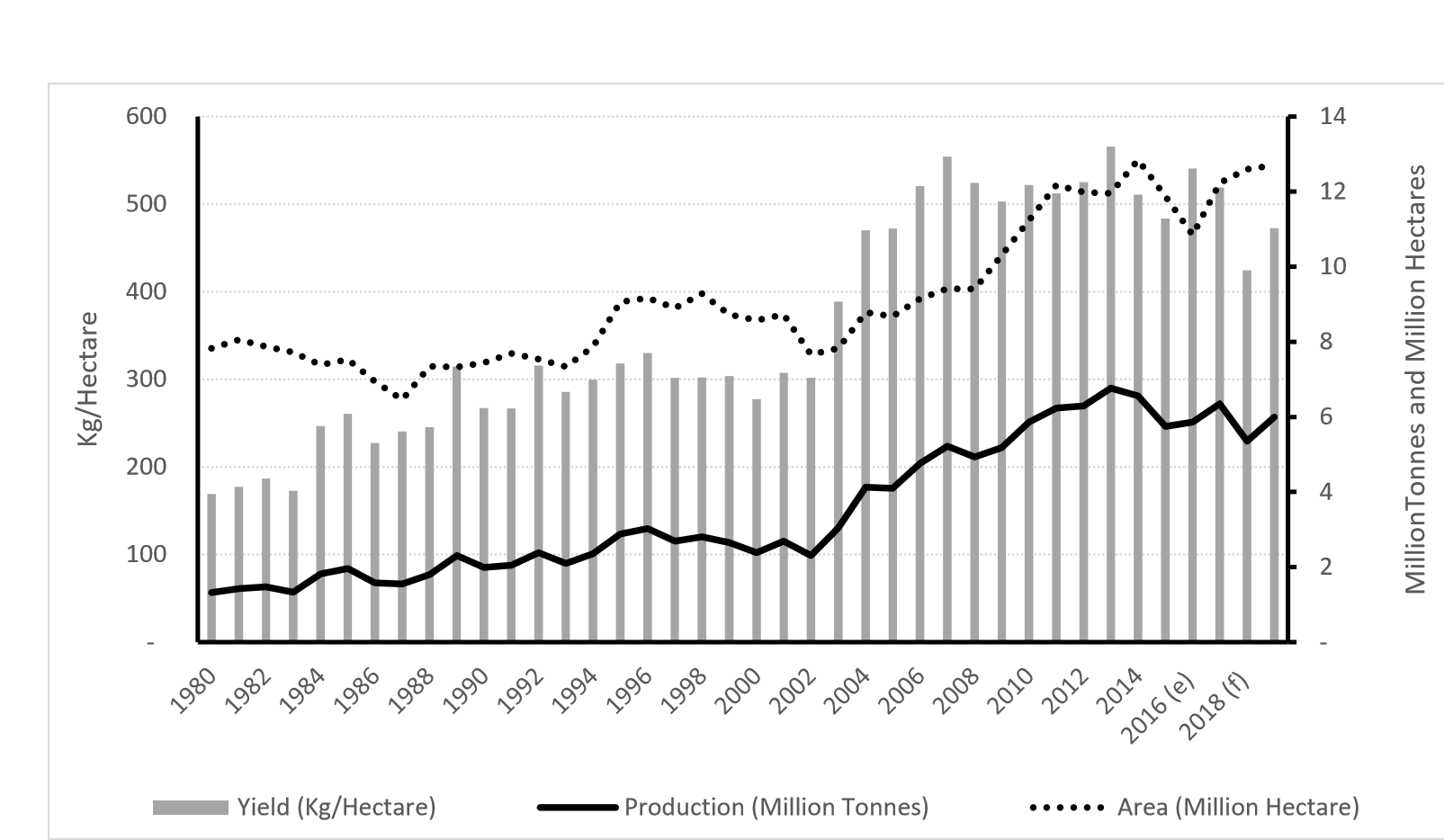
The authors’ obsession is with the period 2000 to 2006, when the area under Bt cotton was not significant. What raised yields during this period? The ‘Perspective’ concludes it was an increase in fertilizer use. This argument has been previously made by one of the authors8 and others9. Table 1 provides information on the factors that could have affected the yield. The data presented in the table highlights two major contradictions: one, in the lint-yield data from the Ministry of Agriculture (MoA) and the Ministry of Textiles (MoT); two, in the fertilizer usage data based on estimates compared to data from an actual survey of inputs among cotton growers, submitted every four years to the Parliament of India.

If we go by the actual input survey-based fertilizer usage data presented in the table, fertilizer could not have been the reason for the yield increase between 2000 and 2006. A significant yield increase in 2003 over 2002 cannot be ascribed to fertilizers; even the MoA estimates show no increase in fertilizer usage. Yield data from MoT show stagnation between 1996 and 2002; MoA data show a 39% decrease.
Some stress on cotton cultivation between 1999 and 2002 is made apparent by the data presented in the table. The area under cotton cultivation fell by 20% and recovered to the 1996 level only in 2006. Two important facts need to be highlighted. The period between 1999 and 2004 experienced less than normal rain in the monsoon months, and the area under cotton hybrids steadily increased from 24% in 1996 to 75% in 2004, with most of the new hybrids being from private companies10. In 2004 only 5.5% of the area was under Bt hybrids. The real upward trend in cotton production was seen from 2006 onwards, when lint yields crossed 500 kg/Ha, and the area under cotton cultivation started increasing steadily (Figure 1a). Cotton with the Bt trait covered 36% of the area in 2006, which expanded to more than 85% of the area by 2010.
To sum up, hybrids were popular even before Bt expansion. Cotton with the Bt trait showed expansion from only 0.4% of the 7.67 mH area in 2002 (mostly illegal) to 95% of the 12.82 mH under cotton cultivation in 2014. Was the increase in area due to enhanced fertilizer usage, hybrids, or the Bt trait? The above analysis shows it was due to the Bt trait. The big question is whether farmers feel more secure with in-built resistance as compared to the extensive use of pesticides. All pesticides carry warnings of being toxic. Moreover, pesticide poisoning is quite common on the rural side of India, and most of the farmer suicides in the country have been caused by pesticide consumption. The rapid spread of the Bt trait was not a fad, but a decision based on technology choice and economic benefits.
Why yields are stagnating in India?
The switch to G. hirsutum in India was precipitated by the need of the industry for long-staple cotton11. The first G. hirsutum hybrids were released by the public system breeders in 1970. Recommended dose of 200 kg/Ha fertilizer (100N:50P:50K) and sparse planting have been long-standing recommendations for hybrid cultivation under irrigation. The Bt trait cannot and should not be implicated either for yield stagnation or the increased production costs, beyond the seed price.
The real reason behind yield stagnation is the lackadaisical performance of public-funded research in India. One of the authors of the perspective article served as the director of the Central Cotton Research Institute, an institute of the Indian Council of Agricultural Research (ICAR) with an exclusive mandate for cotton improvement. He has proposed high-density planting, an agronomic practice implemented in China12 resulting in a national average yield of more than 1,600 T/Ha of lint in recent years (Figure 1b).
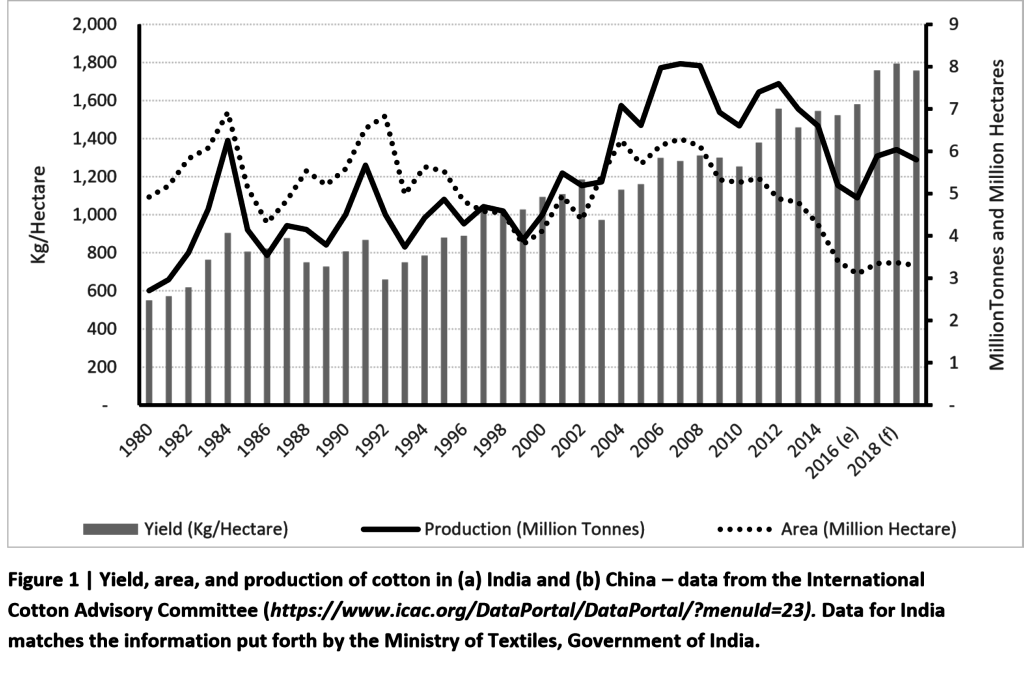
Why wasn’t this technology demonstrated at a large scale to provide farmers with a high-output alternative? Why has there been so little work on broadening the genetic base of G. hirsutum germplasm by introgressions from exotic high-yielding determinate types, desi cottons, and wild species?
The reality is that very little work has been published from India on the genetics and genomics of cotton. Whatever work has been carried out with public funding to develop GE events with high Bt trait expression13 and whitefly resistance14 has been sitting on the shelf. The All India Coordinated Research Programme (AICRP) on cotton has access to a large number of trial sites for evaluating the performance of public-bred varieties and hybrids. No trials have ever been conducted to compare public varieties with both public- and private-bred hybrids to guide the farmers who are struggling with more than 1,000 hybrids on the market.
If investments in public-funded research continue to stagnate, cotton farmers may have to reduce or abandon cotton cultivation, putting the future of millions of farmers and workers in the textile industry in jeopardy. The authors of the Perspective rightly warn of a bleak future for cotton in India, but wrongly attribute it to the Bt trait. The future is bleak due to poor investments in research and development.
Conclusions
There are major disparities in what consumers and farmers would like to see when it comes to agriculture. Consumers want cheap products produced with less fertilizer and, of course, without pesticides. The word “organic” is so enticing for consumers as it suggests not only healthier products but farming practices that are better for the environment. On the other hand, farmers would be happy with low-input, high-output agriculture – low in terms of monetary inputs and high in yields and incomes. This is even more critical for farmers with small holdings; survival is not enough, they need high productivity to generate a surplus.
Despite extensive inputs from some of the major science academies around the world on the safety of GE crops, those who oppose the use of the GE technology seem to have the upper hand. Both in the developed and developing regions of the world, there is an undercurrent of guilt for contributing to environmental degradation. Opposing the use of GE technologies provides catharsis from the guilt without making any individual level sacrifices.
However, the ‘arms race’ between the pests and crops is real, and there was no golden period in agriculture that we can go back to. Gene-based solutions, like in the case of dreaded wheat rusts and the Bt trait have been useful in reducing the need for pesticides. The use of pesticides in agriculture is very high (Figure 2); despite that, a lot of productivity gains are being lost to pests16. Genome sequences, GE technologies, and the more recent genome editing technologies have enhanced the possibilities for gene-based solutions.

As in cotton, every crop requires multiple trait inputs that need to be stacked in the seed and diversified into germplasm of regional interest. Currently, there are too many regulatory and IP fetters on GE-based technologies. Smallholder farmers would benefit only if such seeds were reasonably priced. These issues require urgent consideration both at the national and international level.
Meanwhile, we can do without some members of the scientific community, including the authors of the Perspective article, creating overt17,18,19 or sophisticated obfuscation around GE technologies. Unfortunately, 25 years after the first release of Bt cotton in the US, rather than moving forward, we are still discussing whether ‘to use or not to use’ GE technologies.
Deepak Pental was a professor in the Department of Genetics at the University of Delhi. He is currently a CSIR-Distinguished Scientist at the University. His major research interest is breeding oilseed mustard using conventional and molecular methods
References
1. Kranthi, K.R. and Stone, G.D., 2020. Long-term impacts of Bt cotton in India. Nat. Plants, 6, 188-196. doi: 10.1038/s41477-020-0615-5.
2. Bates, S.L., Zhao, J.Z., Roush, R.T. and Shelton, A.M., 2005. Insect resistance management in GM crops: past, present and future. Nat. Biotech., 23, 57-62. doi: 10.1038/nbt1056
3. Grover, A. and Pental, D., 2003. Breeding objectives and requirements for producing transgenics for major field crops of India. Curr. Sci., 84, 310-320.
4. Hicks, D.J., 2015. Epistemological depth in a GM crops controversy. Studies in History and Philosophy of Science Part C: Biological and Biomedical Sciences, 50, 1-12. doi: 10.1016/j.shpsc.2015.02.002
5. Qaim, M. and Zilberman, D., 2003. Yield effects of genetically modified crops in developing countries. Science, 299, 900-902. doi: 10.1126/science.1080609
6. Kathage, J. and Qaim, M., 2012. Economic impacts and impact dynamics of Bt (Bacillus thuringiensis) cotton in India. Proc. Nat. Acad. Sci., 109, 11652-11656. doi: 10.1073/pnas.1203647109.
7. Suresh, A., Ramasundaram, P., Samuel, J. and Wankhade, S., 2013. Impact of technology and policy on growth and instability of agricultural production: the case of cotton in India. Indian J. Agr. Sci. 83, 939–948.
8. Kranthi, K. R. 2016. Fertilizers gave high yields; Bt only provided cover. Cotton Statistics & News, 39, 1–6. http://caionline.in/site/publications
9. Gutierrez, A.P., Kenmore, P.E. and Rodrigues, A., 2019. When biotechnologists lack objectivity. Curr. Sci., 117, 1422-1429.
10. Nagarajan, L., Pray, C.E., and Naseem, A., 2015. Empirical analysis on the impact of private-sector R&D on cotton productivity in India. AgBioForum, 18, 182-192.
11. Directorate of Cotton Development. 2017. Status Paper of Indian Cotton. Ministry of Agriculture and Farmers Welfare, Government of India, Nagpur.
12. Dai, J. and Dong, H., 2014. Intensive cotton farming technologies in China: Achievements, challenges and countermeasures. Field Crops Res., 155, 99-110. doi: 10.1016/j.fcr.2013.09.017
13. Singh, A.K., Paritosh, K., Kant, U., Burma, P.K. and Pental, D., 2016. High expression of Cry1Ac protein in cotton (Gossypium hirsutum) by combining independent transgenic events that target the protein to cytoplasm and plastids. PloS ONE, 11. e058603. doi: 10.1371/journal.pone.0158603
14. Shukla, A.K., Upadhyay, S.K., Mishra, M., Saurabh, S., Singh, R., Singh, H., Thakur, N., Rai, P., Pandey, P., Hans, A.L. and Srivastava, S., 2016. Expression of an insecticidal fern protein in cotton protects against whitefly. Nat. Biotech., 34, 1046-1051. doi: 10.1038/nbt.3665
15. Carvalho, F. P., 2017. Pesticides, environment, and food safety. Food and Energy Security, 6, 48- 60. doi: 10.1002/fes3.108
16. Savary, S., Willocquet, L., Pethybridge, S.J., Esker, P., McRoberts, N. and Nelson, A., 2019. The global burden of pathogens and pests on major food crops. Nat. Ecol. Evol., 3, 430-439. doi: 10.1038/s41559-018-0793-y
17. Kesavan, P.C. and Swaminathan, M.S., 2018. Modern technologies for sustainable food and nutrition security. Curr. Sci., 115, 1876-1883. doi: 10.18520/cs/v115/i10/1876-1883
18. Pental, D., 2019. When scientists turn against science: exceptionally flawed analysis of plant breeding technologies. Curr. Sci., 117, 932-939. doi: 10.18520/cs/v117/i6/932-939
19. Pental, D., 2020. Preaching objectivity-practicing obfuscation. Curr. Sci., 118, 863-867

